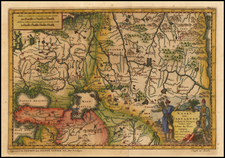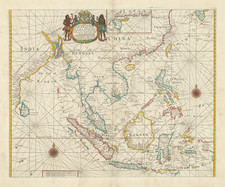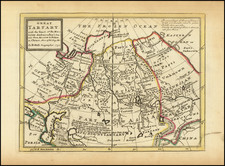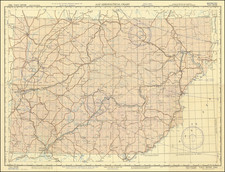A rare large-scale sea chart of Hong Kong's Inner Harbour, issued by the British Admiralty, including highly detailed plans of Victoria (Central) and Kowloon.
The chart embraces the northern shore of Hong Kong Island, running from Victoria to Causeway Bay, and extends northwards across the Inner Harbour to include much of Kowloon (noted on the map as the 'Kaulung Peninsula'). The mapping of the urban areas are very detailed, labeling every street and showing the outline of all major buildings and facilities.
In Victoria we see the outlines of numerous important public buildings, including Government House, City Hall and the Murray Barracks, as well as the great private mansions that graced the mid levels above the town. Victoria Peak is shown to rise majestically above the city. Immediately to the east of Victoria, beyond the Cricket Ground, is the Royal Navy Yard, the headquarters of the British navy in East Asia. The waters before the yard are reserved for the 'Man of War Anchorage', for the navy's new steam-powered dreadnought destroyers. Further east, Wanchai is shown to be in a relatively early stage of urban development, while Causeway Bay is an industrialized area dominated by a large sugar refinery.
To the north, across the harbour on the mainland, is Kowloon which is shown to be only partially urbanized and is almost entirely dedicated to port facilities and associated industrial installations. The shoreline feature numerous large piers backed by warehouses. On the eastern side are the lands reserved for the Kaulung & Canton Railway, and further on is the massive Hong Kong & Whampoa Docks, the maritime center of Hong Kong's greatest industrial concern. Notably the Kowloon Peninsula is noted to be "British", as when this chart was originally made, the peninsula was still a small British enclave clinging to the mainland. While China had ceded Kowloon to British Hong Kong in 1860, the New Territories would not be ceded until 1898.
The chart was highly important during its time as the authoritative maritime pilot for Hong Kong's Inner Harbour, one of Asia's busiest commercial ports. This chart was originally issued in 1888, based on surveys done under the direction of Commander William Moore of the HMS Rambler. It includes vast amounts of nautical information, including innumerable bathymetric soundings, the locations of hazards and shoals, magnetic variation and specific anchorage areas. Beacons are heightened on the chart in yellow.
Owing to extensive use at sea the survival rate of such charts is extremely low. The present chart is scarce on the market, this being the first example we have offered.
The British Admiralty has produced nautical charts since 1795 under the auspices of the United Kingdom Hydrographic Office (HO). Its main task was to provide the Royal Navy with navigational products and service, but since 1821 it has also sold charts to the public.
In 1795, King George III appointed Alexander Dalrymple, a pedantic geographer, to consolidate, catalogue, and improve the Royal Navy’s charts. He produced the first chart as the Hydrographer to the Admiralty in 1802. Dalrymple, known for his sticky personality, served until his death in 1808, when he was succeeded by Captain Thomas Hurd. The HO has been run by naval officers ever since.
Hurd professionalized the office and increased its efficiency. He was succeeded by the Arctic explorer Captain William Parry in 1823. By 1825, the HO was offering over seven hundred charts and views for sale. Under Parry, the HO also began to participate in exploratory expeditions. The first was a joint French-Spanish-British trip to the South Atlantic, a voyage organized in part by the Royal Society of London.
In 1829, Rear-Admiral Sir Francis Beaufort was appointed Hydrographer Royal. Under his management, the HO introduced the wind force scale named for him, as well as began issuing official tide tables (1833). It was under Beaufort that HMS Beagle completed several surveying missions, including its most famous voyage commanded by Captain FitzRoy with Charles Darwin onboard. When Beaufort retired in 1855, the HO had nearly two thousand charts in its catalog.
Later in the nineteenth century, the HO supported the Challenger expedition, which is credited with helping to found the discipline of oceanography. The HO participated in the International Meridian Conference which decided on the Greenwich Meridian as the Prime Meridian. Regulation and standardization of oceanic and navigational measures continued into the twentieth century, with the HO participating at the first International Hydrographic Organization meeting in 1921.
During World War II, the HO chart making facility moved to Taunton, the first purpose-built building it ever inhabited. In 1953, the first purpose-built survey ship went to sea, the HMS Vidal. Today, there is an entire class of survey vessels that make up the Royal Navy’s Hydrographic Squadron. The HO began to computerize their charts in the late 1960s and early 1970s. In 1968, the compilation staff also came to Taunton, and the HO continues to work from there today.














![Province de Chen-Si [Shaanxi Province]](https://storage.googleapis.com/raremaps/img/small/95545.jpg)